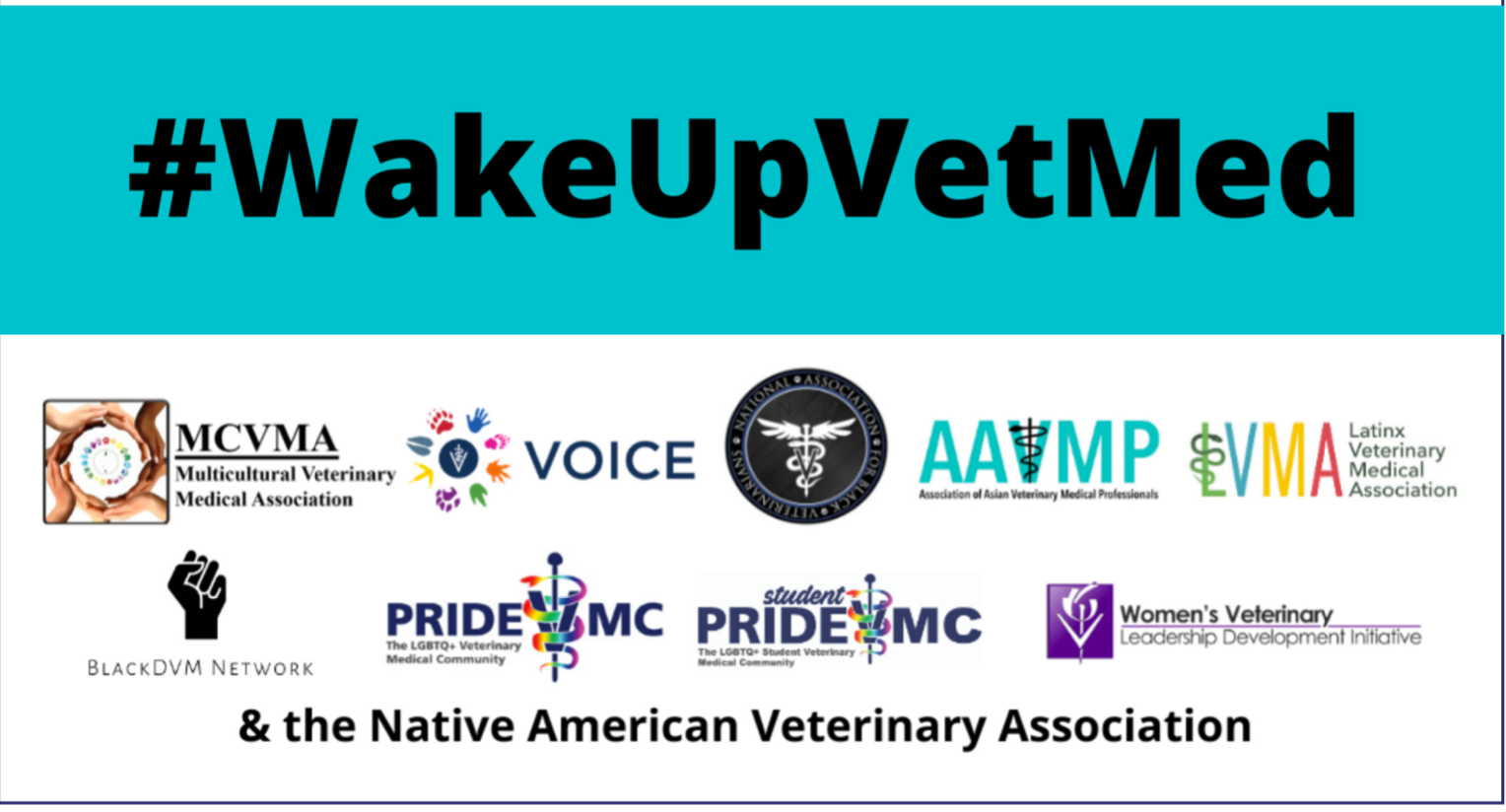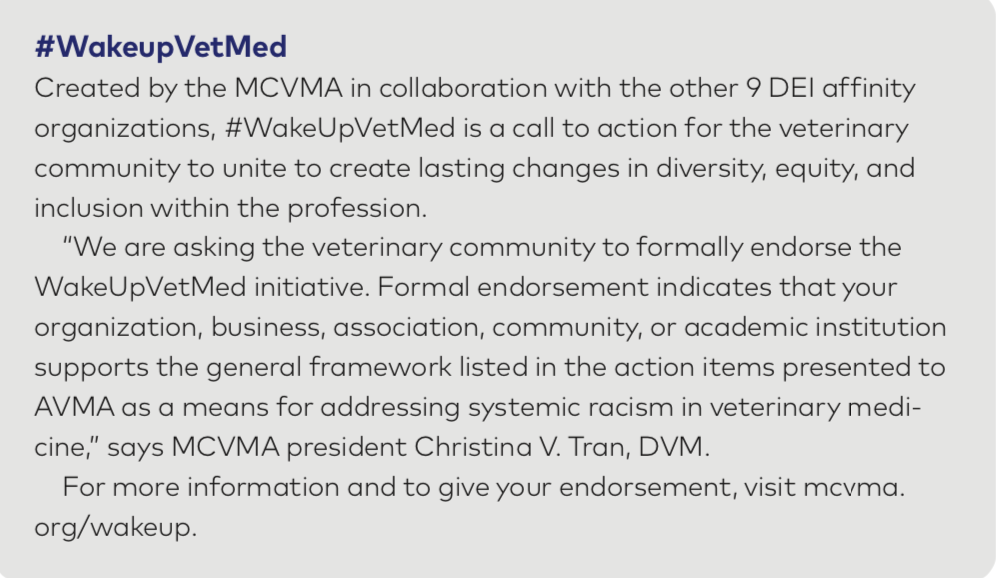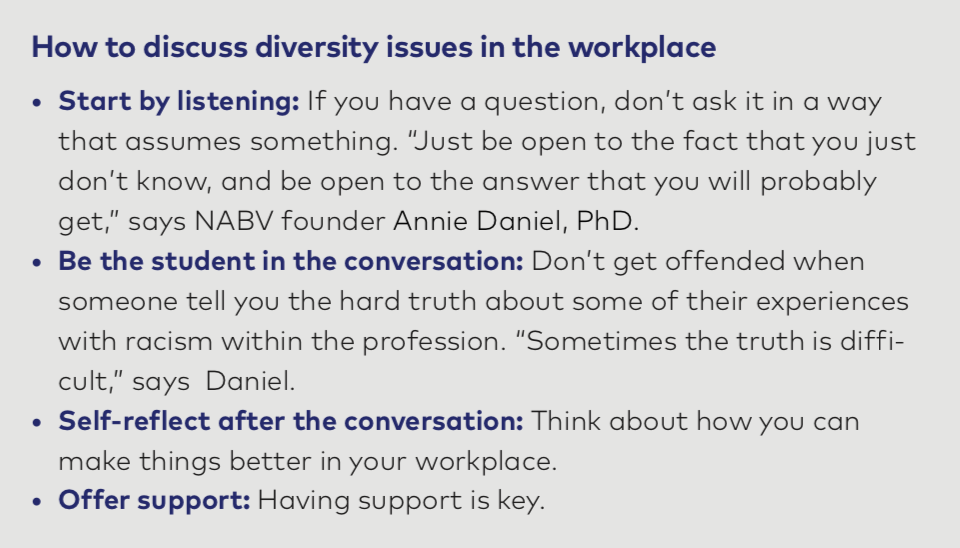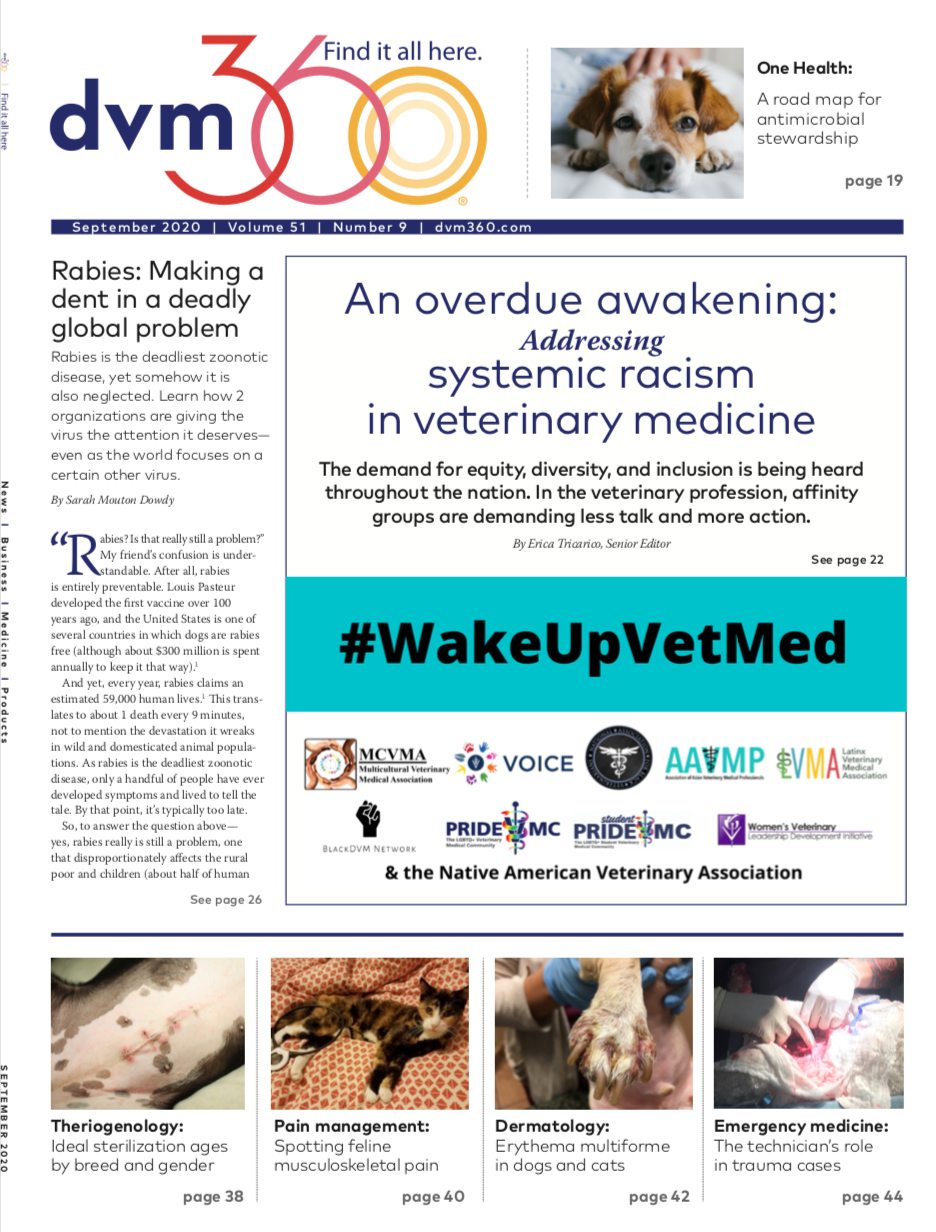An overdue awakening: Addressing systemic racism in veterinary medicine
The demand for equity, diversity, and inclusion is being heard throughout the nation. In the veterinary profession, affinity groups are demanding less talk and more action.

The recent deaths of George Floyd, Breonna Taylor, and Ahmaud Arbery, among many others, have sent shockwaves of anger, sadness, disbelief, and frustration across the nation. For some, these tragedies have served as a testament to the pain and unfair treatment that people of color have experienced for years. For many, they serve as a rude awakening that there is a long way to go in the fight for equality.
The resurgence of the Black Lives Matter movement has refocused efforts on tackling the diversity crisis in veterinary medicine, a profession in which less than 1% of veterinarians are Black, 6.1% are Asian, and 1.6% are Hispanic or Latino, according to 2019 US Bureau of Labor Statistics data.1 AVMA data differ somewhat—according to 2019 census numbers provided by the organization, approximately 2% of veterinarians are Black, 6.1% are Asian, and 3 to 4% are Hispanic—but regardless of the precise number, minorities make up a very small proportion of veterinarians.
According to 2018-2019 data from the American Association of Veterinary Medical Colleges (AAVMC), only 2.1% of veterinary school applicants are Black.2 “I was only 1 of 5 [Black students] in my class of 127,” says BlackDVM Network founder and 2020 graduate Tierra Price, DVM. “I felt pretty alone and distant from other students who looked like me and decided to create an Instagram page to bring us together.”
Krista Miller, DVM, who’s been practicing in Baton Rouge, Louisiana, for more than a decade, says she was 1 of just 2 Black students in her class of 70 at Mississippi State University College of Veterinary Medicine.
“Being one of the only Black students in a predominantly White program constantly makes you think more, more, more...do more, work harder, study longer, dress well, be neat, don’t break a rule, you’re good enough, you’re not here because of your skin color, you deserve this,” Miller tells dvm360®. “Every day felt like a race to the finish line to prove to yourself that you are enough.”

A demand for change
The experiences of Price and Miller reflect the overall picture of race in the veterinary profession today. For years, veterinary students and professionals of color have felt isolated, misunderstood, and subject to racism by clients, colleagues, and professors alike. Some say they were qualified for but not accepted into veterinary programs, or advised to find a different career. Others say they have been mocked for their accents or “ethnic” names, or told by clients that their dogs don’t like Black people.
“I have talked to a lot of veterinarians, some of whom had no other choice but to go to Tuskegee (the only historically black college/university with a veterinary school),” says Annie Daniel, PhD, founder of the National Association for Black Veterinarians. “I think that is changing, especially since our organization and others have really boldly presented how racism and discrimination are affecting the profession. The profession is going to have to think long and hard after all these years about how they are going to level the playing field.”
Efforts have been made over the years to address the dismal lack of diversity in veterinary medicine. In 2004, the AAVMC named Lisa Greenhill, MPA, EdD, as associate executive director of diversity and, in 2005, the American Veterinary Medical Association (AVMA) commissioned a Diversity Task Force and launched Diversity Matters, a national plan devoted to increasing diversity in academic veterinary medicine.
The AAVMC has long been engaged in promoting diversity, equity, and inclusion (DEI)
in academic veterinary medicine, Greenhill tells dvm360®. Some of the association’s efforts include conducting and publishing diversity-related research; offering lectures, workshops, and symposia; and providing access to numerous additional resources for member institutions.
Greenhill also hosts AAVMC’s Diversity & Inclusion On Air podcast, which features conversations – with veterinary professionals, students, sociologists, educators, and other guests of diverse races, backgrounds, and genders – about a wide array of topics ranging from the cultural nuances of dressing for interviews to discrimination in the workplace to how to have conversations about race.
“Given our work at AAVMC, I think the colleges of veterinary medicine are further ahead than the rest of the profession. Colleges are actively recruiting students from a wider variety of backgrounds. They are using evidence-based methods to more holistically assess applicants,” says Greenhill.
According to AAVMC data, the number of racially underrepresented veterinary students enrolled at US veterinary colleges now stands at just under 20%.2 “We are making strides, but when those 20% graduate, what happens? Are they making their way to leadership? They should,” Christina V. Tran, DVM, associate professor and clinical relations lead veterinarian at the University of Arizona College of Veterinary Medicine, and president of the Multicultural Veterinary Medical Association (MCVMA),” tells dvm360®.
“I think diversity, and specifically inclusion, are a continuum. You don’t get to an endpoint,” Tran says. “Just like in veterinary medicine, you don’t ever get to a point where you’ve learned everything there is to know. You can’t just learn some diversity vocabulary and not apply it.”
Coming together to create change
In recent years and even months, many DEI groups have cropped up across the nation to promote underrepresented populations and create a safe space for minorities to connect and elevate one another. Recently, these affinity groups have unified to help create permanent change within the profession.
“I think it’s great that we formed a tight-knit community as minorities and have been able to support each other and come up with more solid ways to demand change in our field,” says Stephanie Kuo, a fourth-year student at St. George’s University School of Veterinary Medicine and co-founder of the Association of Asian Veterinary Medical Professionals.

On July 25, the groups met with AVMA leadership via videoconference to present a number of actions they would like AVMA to take to improve DEI within the profession (see #WakeUpVetMed):
- Self-assessment: Explain where AVMA currently stands with regard to DEI.
- Accessibility: Ensure an equitable process for all members, regardless of race, to join and grow within AVMA leadership.
- Accountability and transparency: Implement processes for which AVMA will be held accountable with in regards to DEI initiatives.
- Expanding membership: Identify opportunities to increase DEI membership in AVMA.
- Organizational commitment: Ensure that AVMA leadership is culturally competent and acting in the best interests of all members.
- Investment: Provide financial and structural commitments to improve the state of DEI in veterinary medicine.
- Outreach and engagement: Advance lasting DEI initiatives between AVMA partners, state veterinary medical associations, constituent allied veterinary organizations, academic institutions, veterinary practices, and associates.
“[That] videoconference was a first step toward the AVMA working collaboratively with the DEI affinity organizations to address systemic racism in the profession,” Tran says. “And while it was a good call, there is much work to be done.”
The DEI groups also put out a call to action asking AVMA members to contact their House of Delegates representative to address systemic racism within the profession.
At the request of the AVMA, the 10 affinity groups (led by the MCVMA) created a powerful video illustrating why these DEI initiatives are so important and why these efforts need to be made now. It’s fair to say that the video, which was shared widely on social media, made an impact. (Check it out at https://www.youtube.com/watch?v=j7Pl4YX_QNc&t=14s).
“Everyone I spoke with was greatly moved by these searing personal accounts,” AVMA President Douglas Kratt, DVM, tells dvm360®. “These types of stories—not only in veterinary medicine, but across our society—illustrate the need for action to advance DEI and fight racism wherever it is found. We’re committed to using our platform and voice to promote diversity and inclusion.”
“We know that words not backed by action are hollow,” Kratt continues. “I am confident that we are on the path to meaningful and lasting change. That means barriers are removed, opportunities are expanded, and everyone is appreciated for what they bring to veterinary medicine and to society.”
At its meeting on July 29, the AVMA Board of Directors committed to hiring an external DEI consultant to help identify areas of greatest need, set priorities, and use resources most effectively. The board also approved the formation of an industry-wide commission to examine DEI issues affecting veterinary medicine. Two days later, during its annual meeting, the House of Delegates approved these actions and asked the Board to also implement the following:
- Establish DEI as its own strategic focus for the association.
- Communicate regularly with the House of Delegates and AVMA/ Student AVMA (SAVMA) membership about progress addressing DEI within both the association and the profession as a whole.
- Promote AVMA DEI resources to its professional and
student members.

Where do we go from here?
So, what changes can the profession expect in the coming months? According to Kratt, many. Among the AVMA’s immediate goals: to define its scope of work and identify DEI consultant candidates by September 15, and by October 1 to have consensus on and a description for the DEI entity it has promised to create.
The AVMA says it is also committing to develop new educational programming and bring Black leaders in veterinary medicine to the forefront to share their experiences and help make the profession more accessible to the Black community and other underrepresented groups.
“Diversity, equity, and inclusion are essential for a thriving, healthy veterinary profession that serves all communities across the nation,” says Kratt.
While Greenhill is hopeful about the future of veterinary medicine, she says there are still many in the profession who see [diversity and inclusion] issues as identity politics, almost as if “forcing change is somehow detrimental to White populations,” she explains.
“Our individual identities shape the way we see the world, underpin how we process and use new knowledge, how we problem solve, how we see clients and engage with them and them with us, and colors our inter-and intra-professional identities. As we all plan for the next 50-plus years, I’m hopeful that more professionals will read the tea leaves, note the global population changes, the increasing desire for more people of color to pursue veterinary careers and conclude that there is a need to pay attention,” Greenhill concludes.
“Resistance to change with respect to diversity and inclusion is going to leave the profession vulnerable to radical external change.”

References
1. Labor force statistics from the current population survey. US Bureau of Labor Statistics. Table 11. Employed persons by detailed occupation, sex, race, and Hispanic or Latino ethnicity. Accessed September 3, 2020. www.bls.gov/ cps/cpsaat11.htm
2. Annual data report 2018-2019. Association of American Veterinary Medical Colleges. Accessed September 3, 2020. file:///Users/ mmckinney/Desktop/2019%20 aavmc%20annual%20data%20 report%20(id%20100175).pdf
